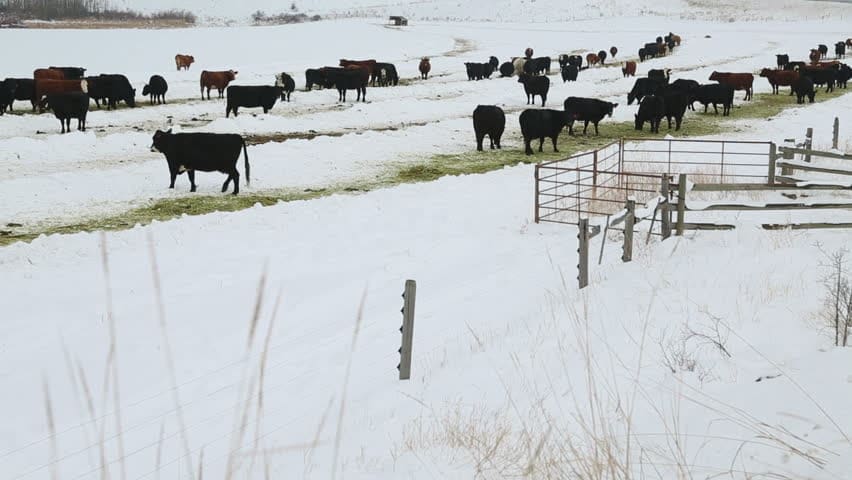Feeding beef cattle during the winter can be a challenging experience if being profitable is also one of your goals. Proper nutrition is a key component for a successful cow/calf operation. Cows go through many physiological changes during a year. The winter/early spring feeding period is one of the most critical times to provide adequate nutrition for the cow because of her needs at calving time.
Feed usually accounts for the single largest input cost associated with beef cattle. The winter feeding period generally becomes the largest portion of this cost. Stored feeds such as hay normally cost producers 3-5 times as much as grazing a summer pasture or stockpiled feed in a paddock, when cost is calculated. It’s therefore critical to keep the amount of stored feed fed to an acceptable minimum so costs are kept under control, but you must still feed enough hay to meet the nutritional needs of the cow. We must maintain the cow’s dietary needs if strong healthy calves are to be born in the spring and also get cows rebred in a timely manner to maintain acceptable calving intervals.
So, we quickly see how over feeding becomes costly, but don’t ever forget that under nourished cows may be a disaster. Under nourished cows are ones not receiving enough nutrients from their feed. Notice I did not say, its cows not being fed enough hay. Cows can be under nourished even though they are eating all they can eat. Feeding the correct quantity of hay is important, but feeding the correct quality of the hay during each production stage is the key.
We often use the figures 2.5 – 3% of a cows body weight as the amount of dry matter (DM) a beef animal needs per day. So, a 1300 lb. cow would require approximately 33-39 lbs. of DM each day. Don’t forget this is a DM calculation. To calculate the amount of hay we must actually feed we must account for the moisture in the hay. Most stored hay will be roughly 90% DM so we divide our 33-39 lbs. by 90% (.90) and get an as fed amount of 37-43lbs. of hay per day for our 1300 lb. cow.
Here’s the catch. Doing these calculations still does not assure us the proper amounts of nutrients are being fed. Remember we said cows can starve eating all they could eat. Quality of hay must be accounted for to ensure the nutrients being fed are adequate. Poor quality hay has high percentages of non-digestible (neutral detergent fiber-NDF) material in it. Because of this a cow can not eat more than about 1.5% of her body weight in NDF. Poor quality forage does not pass through the rumen as quickly as high quality forage, hence the cow is full but still lacks the nutrients she needs to maintain productivity.
Laboratory forage analyses I’ve had done sometimes reveal that hay does not contain the nutrients I thought it might. Sometimes this happens because of unexpected changes in weather conditions that delay making hay, but other times it’s because of management decisions. I’ve heard some producers boast of how many round bales they rolled up in one day or how well their round bales keep their shape and not sag after baling. However, what they really may be saying is that they have a lot of poor quality hay, which was made after it was very mature (with a high NDF value), and it won’t be able to meet the nutritional needs of their livestock during the winter feeding period.
Many factors must be taken into consideration when feeding cows. Frame size, body condition, age of the cows, time of the year, stage of gestation, types of feed, feed quality, fluctuations in air temperature, mud, rainfall and the list could go on. Animals require energy for maintenance, growth, work, and milk or meat production. Feeds are evaluated in terms of the amount of energy and crude protein the animal can obtain from them.
Providing the correct quantity and quality of feed, at the proper time, is what producers must do to maximize production, maintain cows in proper body condition and keep costs under control. Remember we said feeding beef cattle during winter can be a challenging experience. While we certainly want to feed enough nutrients, likewise we do not want to feed too many expensive nutrients if the hay is above average quality or very high in quality.
Knowledge of your hay’s quality, the amount consumed and nutrient needs for all classes of livestock in your operation is essential to make the best use of forages available. Nutritional needs for cattle of various ages, weights and production stages are published in numerous places and easy to obtain. Accurate nutritional data of your hay lots will only be known if you have laboratory analyses done.
Laboratory forage testing results are often returned within one week. It’s not too late to take samples and have an analysis done to calculate if you’re livestock can get enough nutrients from the hay you are feeding.
Whatever method one uses to determine quantities of feed fed, producers should regularly monitor body condition of all livestock. This will help verify if nutrients being fed are calculated properly, distribution among all animals is adequate and boss cows are not keeping timid cows from eating enough forage, causing them to loose weight. A body condition scoring chart that shows pictures and lists body condition descriptions may be found at http://ohioline.osu.edu/l292/index.html
Source: Mark Landefeld, Agricultural Educator, Monroe County, Buckeye Hills EERA

